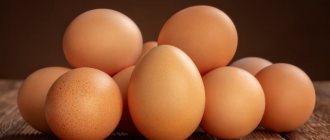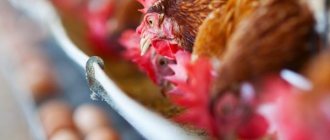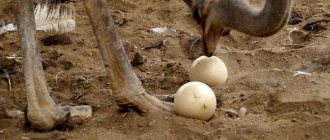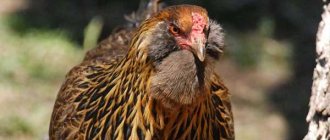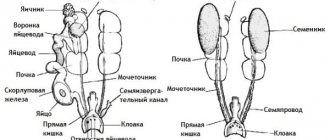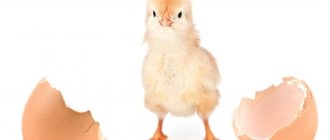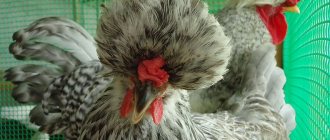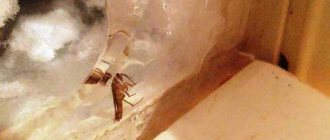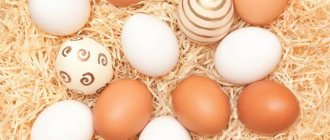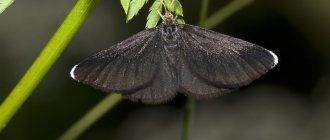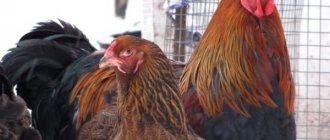Home » Articles about chickens » Breeds of chickens with blue eggs
Breeds of chickens with blue eggs are few in number and therefore are of particular interest. The colored shell does not impart any unique properties to the product - despite the “Easter” appearance, the eggs do not differ in taste and composition from ordinary eggs.
Reasons for the formation of colored shells
Chickens that lay blue and green eggs have a specific gene SLCO1B3 with the endogenous retrovirus EAV-HP built into it. This gene affects the transport of bile acids. The green color is formed by the action of biliverdin and oocyanin. Since this happens at the initial stages of shell formation, it is stained throughout its entire thickness.
The mechanism for coloring brown eggs is completely different. The colored layer is formed under the influence of protoporphyrin - it is produced by the cells of the oviduct. When an egg passes through it, the shell is stained only on the outside; the inside remains white.
In both cases, we cannot talk about the constancy of the resulting shade. Its saturation depends on the rate of shell formation, the age of the hen, the breed of bird, the time of year and other factors.
Selection
Breeds in which laying hens lay green eggs can be used in breeding - purebred roosters are crossed with hens that have standard characteristics. A non-standard trait is transmitted from the parent to the offspring, since it is dominant.
The result depends on the initial breed characteristics of the females. If they lay dark brown eggs, the next generation will have a marsh or deep olive shell color. With a light brown shell, the result will be a bluish mint hue. If the original color is white, then the shade of the shell will be light green.
In some cases, it is possible to achieve unusual shades - with a lilac or purple undertone. The next generation of chickens most likely will not retain the newly acquired characteristics - the characteristics are split. The farmer will have to experiment again, crossing individuals with the desired qualities.
Araucana
This breed of chicken has been known since ancient times - the first mention dates back to 1526. Origin: South America, named after an Indian tribe. Araucanas appeared in Europe in the 19th century. Since then, breeding work has been carried out to improve them, which made it possible to obtain several subspecies, including the dwarf one.
Birds have a varied appearance - it depends on where the selection was carried out. German Araucanas do not have a tail - they lack a tailbone. Birds of English and American selection have a tail. The type of plumage on the head also depends on the subspecies. The standards allow the presence of:
- barbs and feather tufts growing from the ears;
- goatees and sideburns.
Araucanians have a compact body with a convex chest. The neck is thick, the head is small, the crest is pisiform. The legs are strong, the paws are four-toed, and the wings are small. The plumage can have different colors - the most common Araucanas are white, black, black-red, golden, and wheaten.
The birds have a calm character. Productivity is average. Chickens weigh about 1.4-1.6 kg, roosters - 2 kg. Over the course of a year, laying hens lay up to 180 eggs with blue or greenish shells. Weight 1 pc. – 50 g. Maternal instinct preserved.
song thrush
So far there is one explanation for this coloration of eggs. The blue color of the eggs does not allow ultraviolet rays to pass through, which destroy the DNA of the chicks, but infrared radiation perfectly passes through such a shell and heats the eggs, accelerating the growth process of the chicks.
Blackbirds prefer to build nests in trees or dense thickets. They build nests from veto, moss and grass. The finished blackbird nest is coated with clay to enhance its strength.
In one clutch, the female thrush lays up to five eggs. She incubates them on her own for ten days. After hatching from the egg, the chicks are fed insects and berries. Already at the age of fourteen days, thrush chicks become more or less independent.
These birds adapt well to different living conditions. They can live calmly in the city and are not afraid of people.
The diet of song thrushes is quite varied and differs depending on the habitat and time of year.
The main dish for most of the year for blackbirds is worms. In autumn they feed on seeds and snails, flies, and spiders.
Ameraucana
This breed of chicken, which lays blue eggs, was bred in North America based on the Araucanian and American chickens. Birds have a harmonious physique. The metatarsus are not feathered, the paws are four-toed. The neck is of medium length, the head is decorated with sideburns and a beard - feathers grow in tufts. The comb is pisiform. The standards allow 8 color options. The most common chickens are white, black, wheat, and blue. The color of the metatarsus differs among different subspecies. General characteristics: white skin on the pads of the feet and toes.
The weight of Ameraucana hens and roosters is 2.5 and 3 kg, respectively. The meat is very tasty. Puberty occurs at 5-6 months. Egg productivity - 200-250 eggs per year weighing 60 g. The shell color is most often green or blue, but can also be brown-red.
What are the colors of eggs in different breeds of chickens?
The most common eggs are white, beige and brown, with or without dots and speckles. But there are many chickens in the world that lay colored products. The shell can be green, blue, turquoise, yellow, olive, salad and other original colors. Since the nutrition of laying hens affects the taste, but not the color, eggs of any color are used in cooking.
Blue chicken eggs - a genetic mystery
The benefits of taking a colored product are high. It contains important B vitamins, retinol, vitamin C, micro- and macroelements (magnesium, selenium, potassium), amino acids.
Important! It is better not to eat soft-boiled blue eggs. They are often infected with salmonellosis. Therefore, deep heat treatment is required.
Grünleger
The list of chicken breeds that lay blue eggs includes the Grunleger. The breed originates from Austria. The selection is based on Araucanas, as well as local hybrids. The birds have a dense build with a convex chest. The paws are of medium length, the metatarsals are not feathered. The neck is thickened due to the mane. There is a beard. The comb is leaf-shaped. Chickens weigh 1.8 kg, roosters - up to 2.5 kg. Number of eggs per year – 300 pcs. weighing up to 60 g. Various colors. The color of the shell is blue, olive, turquoise.
Who else lays blue eggs?
There are other birds with this feature in nature:
- finch;
- thrush;
- starling.
Among the domestic ones are some breeds of ducks. Moreover, they have their own reasons for coloring, not caused by a viral disease.
Any color of the shell is due to the release of pigments in the hen's stomach. This is explained both by initially laid down programs and genetic changes.
Blue eggs are rich in unique acids and have a positive effect on humans. But there is no need to attribute to them qualities that they do not possess: the absence of cholesterol and cleansing the body of it.
Olive Eggers
Interbreed hybrids obtained with the participation of the Araucana, Ameraucana, and Marano breeds are known under this name. Birds have lush plumage - it can have different shades. There is a beautiful mane on the neck. There is a goatee and sideburns. The comb is small. The character of chickens is calm and fearless. Egg production – 200 pcs. Weight – 65 g. The shell is blue, olive or turquoise.
Uheiliyuy
Birds are unique - in addition to laying eggs with unusually colored shells, they have other features. The plumage, skin, meat, eyes and even bones of the eel are black. The feathers have a beautiful green tint, the comb is leaf-shaped, with a purple tint. In roosters it is large, in females it is small.
The bird's body is compact, the chest and wings are well developed. The tail is long. Paws of medium length, black and gray. Adults weigh 1.5-2 kg. The meat is very tasty and healthy. Sexual maturity occurs at 6-8 months. Egg production -160-180 pcs. (48-53 g). The shell is bluish-green.
Selection
Breeds in which hens lay green eggs can be used for breeding - purebred roosters are crossed with hens with standard traits. The substandard trait is passed on from parents to offspring because it is the dominant trait.
The result depends on the initial breed characteristics of the chickens. If they lay dark brown eggs, the shells of the next generation will be swampy or dark olive brown. If the eggshell is light brown in color, the result will be a bluish mint color. If the original color is white, the shade of the shells will be light green.
In some cases, you can get unusual shades with lilac or purple undertones. The next generation of chickens is unlikely to retain the newly acquired trait - the traits are divided. The farmer will have to experiment again, crossing individuals with the appropriate characteristics.
Xin xin yayan
The bird's body is graceful, the tail is raised high in relation to the back. The neck is of medium length. The comb is leaf-shaped, large. The color can be tan, red or black. The last option looks the most impressive. Chickens weigh 1.2-1.5 kg, roosters - 1.8-2 kg. Egg production – up to 200 pcs. Sexual maturity occurs at 4.5-5 months. The shell color is bluish, green or olive. The character is calm.
Diseases
Failure to comply with sanitary and hygienic standards in poultry premises can lead to infection of livestock with parasitic and infectious diseases, such as salmonellosis. Young laying hens that have recently reached sexual maturity and started laying eggs are susceptible to cloacitis.
Symptoms of acute and permanent forms of the disease, treatment and prevention
Salmonellosis
Inflammatory disease of chickens caused by errors in feeding and maintenance
Cloacite
Excellent 1
Liuyang Wuji
This breed of chicken lays blue eggs. It is considered one of the oldest - known for more than 1600 years. Like the Wuheiliu, the Liuyang Wuji has black skin, feathers, meat, bones, and internal organs. The birds have an almost square body, a high tail, a long neck, and muscular thick legs. The comb and beard are fleshy, black or purple. The wings are strong. Roosters fatten up to 2.8 kg, chickens – up to 2.5 kg. The meat is juicy, tender, healthy. Egg production – up to 140 pcs. (55-60 g).
Features of breeding and maintenance
It is not enough to know what breed of chicken lays green eggs; you need to study the requirements for keeping such birds. Some representatives of the "Easter" group need special treatment (one example is Grünleger).
When purchasing hatching material for breeding, there is a risk of getting hybrids - in this case, the chickens may well not have the characteristics that were declared. Even contacting large poultry farms does not become insurance. To form a purebred herd, it is better to purchase adults or young animals that correspond to the breed characteristics. The disadvantage of this solution is that you will have to pay more.
Sources of calcium must be present - shell (2%), chalk (8%).
Lakedanzi
Chickens of this breed, which lay blue eggs, are often confused with ukheiliyu. Lakedanzi is slightly larger (1.6-2.5 kg). The color of the plumage is wild (black and red), and not monochromatic. Sexual maturity occurs at 4.5-5 months. Laying hens lay up to 200 eggs. The body is compact. The chest and wings are well developed. The comb is large, purple, with a red tint. A common feature with the Ukheiliyu is the black color of the skin, bones, and entrails. The birds are active, non-aggressive, and get along well with other members of the poultry yard.
Is multi-colored food good for you?
Eggs vary in color, white to yolk ratio, and even chemical composition, but are very similar in taste.
There is more than enough information about the benefits of eggs with unusual colors. But there is little confirmed information. In 2014, the results of a study by Elena Vladimirovna Tereshina, Doctor of Biological Sciences, were published. The material was eggs of the Ukheyilyu breed.
It revealed:
- Of the total amino acids, 50% are essential - linoleic and arachidonic. The human body does not synthesize them, but receives them from food. But the entire immune system is built on them. In terms of quantity, this is 2.5-3 times higher than that of quail or ordinary chicken;
- cholesterol content is 4% lower than in analogues;
- Choline is found in the composition - a substance actively involved in the formation of the brain and nervous system. It is especially necessary for women during pregnancy, as well as their developing babies;
- include omega-3 fatty acids, which is surprising for non-fish foods.
There is information that eggs from unique breeds do not contain cholesterol. This myth has been officially refuted by scientists. The substance is necessarily present in the yolk.
This information is enough to conclude: green and blue eggs are good for health, but moderation is needed in everything.
Cream legbar
Chickens have a uniform golden color, while roosters have noticeable brown stripes. There is a cute forelock on the head. The body is wedge-shaped with a flat back and rounded chest, strong legs. The weight of males and females is 2 and 3.5 kg, respectively. The tail is of medium length, raised 45 degrees in relation to the back. Birds begin to lay eggs at 6-7 months, the shell is blue. Productivity – up to 210 pcs. in year.
Features of breeding and maintenance
It is not enough to know which breed of chicken lays green eggs; it is necessary to study the requirements for breeding such birds. Some members of the Easter group require special treatment (example: Grünleger).
When purchasing hatchery material for breeding, there is a risk of producing crossbred chicks, in which case the chicks may not have the characteristics that have been identified. Even a trip to a large poultry farm is not insurance. To create a purebred flock, it is better to breed adults that match the breed characteristics, or young chickens that have not yet been bred. The downside is that you will have to pay more.
Easter laying hens do not require a special diet and are served on the table.
Sources of calcium such as shells (2%) and chalk (8%) should be present.
